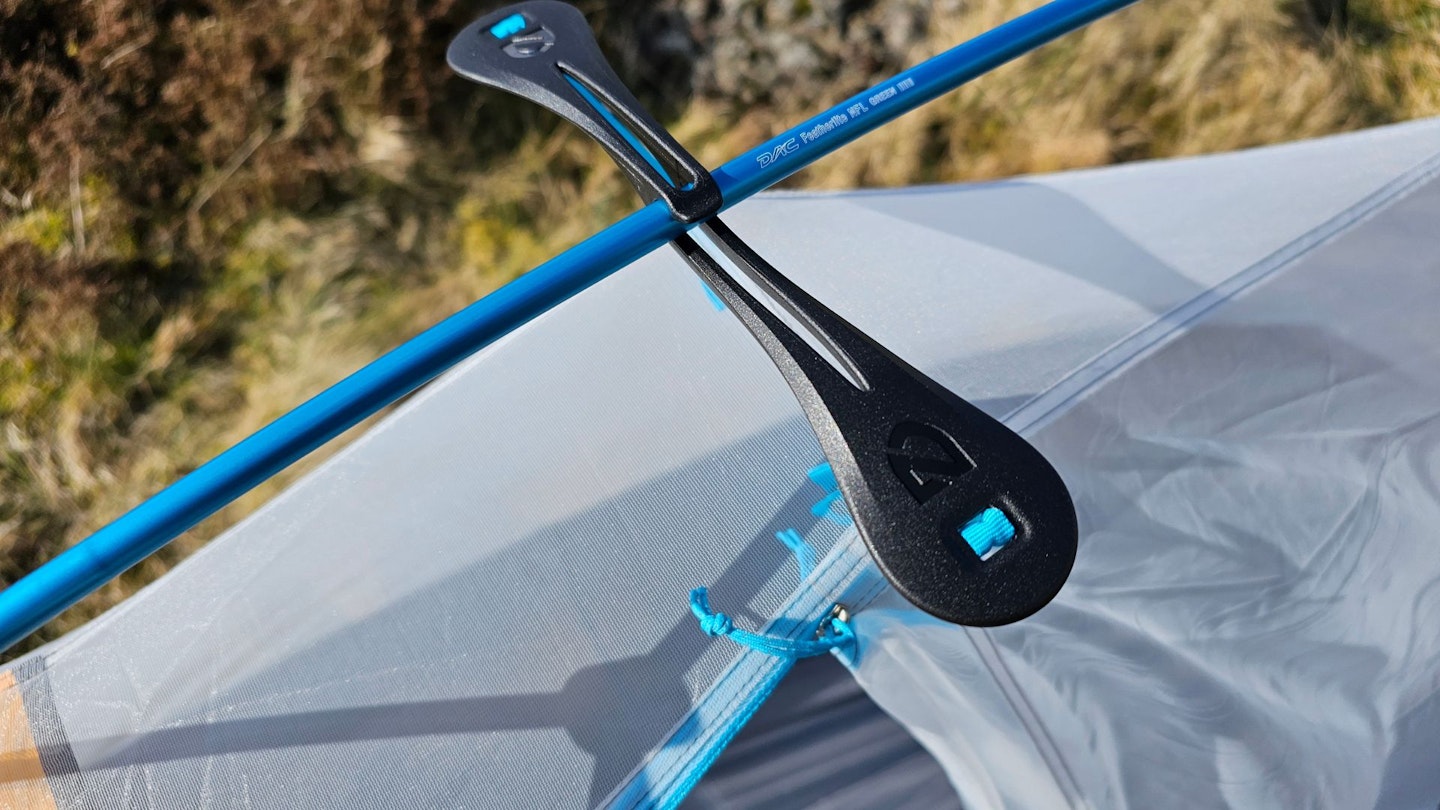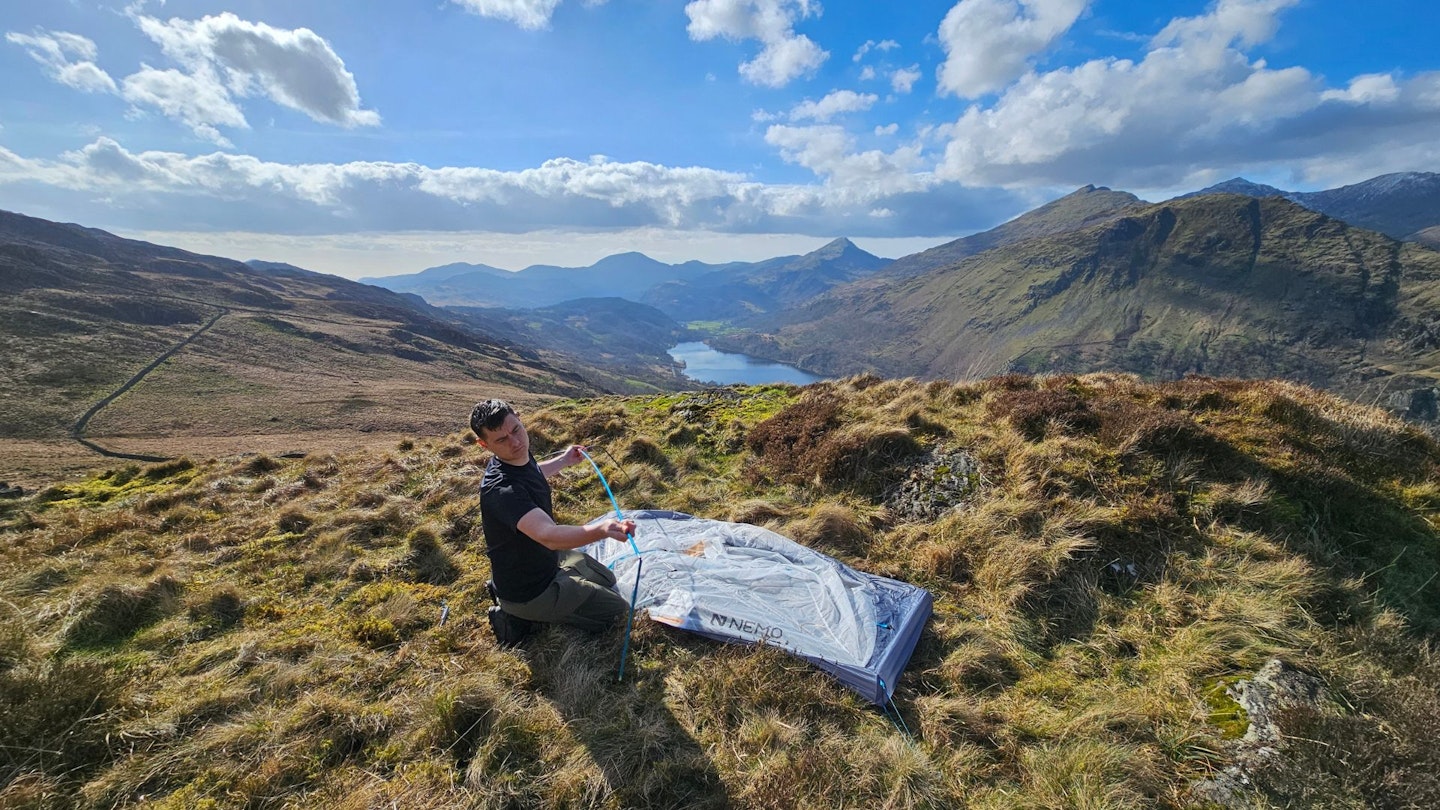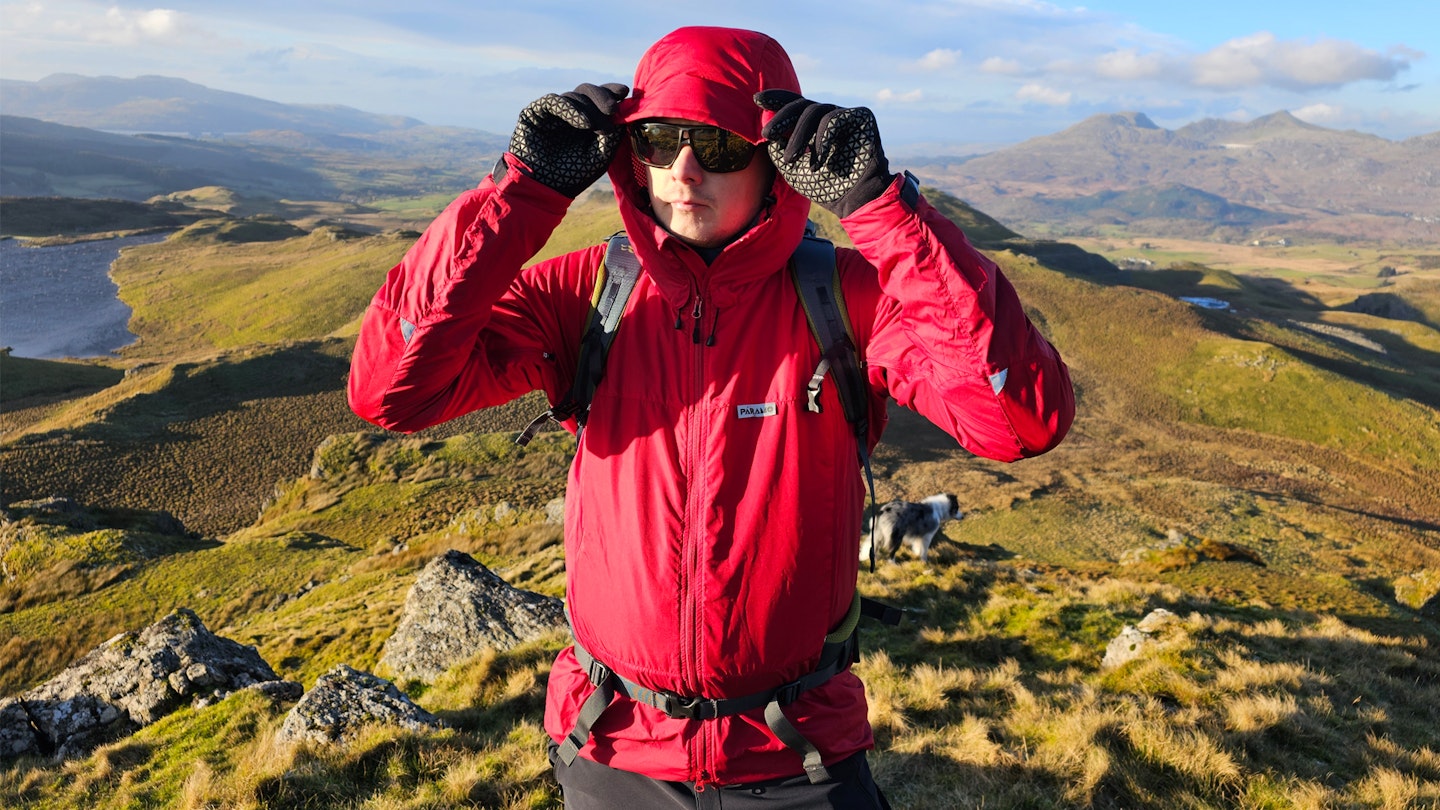NEMO is a well-established US gear manufacturer that has become well-known for its innovative approach to outdoor kit design. We’ve previously tested (and been impressed by) various examples of its lightweight backpacking tents, including the excellent Dagger 2P model.
However, the Hornet Elite OSMO 1 is a different beast. The brand markets this model as ‘the ultimate ultralight tent for extreme minimalists.’ The specs certainly back this up. It has a minimum trail weight of just 657g (minimum weight includes the inner tent, rain fly, poles and tent pegs, but not the stuff sacks). Yep, you read that right. Even the packed weight is a mere 812g, about the same as a large loaf of bread. Which is an impressive feat for a double-skinned design. In fact, on the scales it compares favourably to several ultralight single skin shelters.
 LFTO
LFTOwildbounds.com
Pros
- Lightweight
- Quick and easy to pitch
- Great interior space
- Large vestibule
Cons
- Some rival tents pack down a little smaller
- Not the cheapest
- Pitches inner first
| Type | Freestanding |
| Weight | 812g packed |
| Packed size | 48 x 10cm |
| Doors | 1 |
| Vestibules | 1 |
| Inner | No-See-Um Mesh |
| Fly | OSMO nylon-polyester ripstop blend, 1200mm HH. Made from 100% recycled fibres, PFC-free and flame retardant-free |
| Groundsheet | OSMO nylon-polyester ripstop blend, 1200mm HH. Made from 100% recycled fibres, PFC-free and flame retardant-free |
| Poles | DAC Featherlite NFL 8.7 mm TH72M, green anodizing |
Design and features

This tent uses cutting-edge fabrics that are exclusive to NEMO, in the form of their proprietary OSMO nylon-polyester blend. It’s made from fully recycled fibres and is free from harmful chemicals such as PFC-based water repellent coatings or toxic flame retardants. Meanwhile, the inner tent canopy is made from ultrafine mesh and the pole set uses a hubbed DAC Featherlite NFL TH72 aluminium alloy.

As well as being light in weight, the flysheet fabric is also light in colour. This means that being inside this tent is an airy experience – you almost feel like you’re out in the elements, despite being under cover. In fact, the fabrics are so thin as to be almost translucent. You can see your hand through them, which may make some doubt their durability. However, NEMO claims that OSMO fabric has 3x less stretch than conventional nylon.
It wouldn’t be difficult to puncture it though, and we’d say that use of the additional footprint groundsheet (sold separately) is pretty much an essential – not least because the groundsheet’s worryingly low waterproof rating of 1200mm hydrostatic head seems liable to seepage in wet weather, particularly with the pressure of a sleeping mat and human body on top of it. For reference, a footprint groundsheet for this tent will set you back £65 and cost you an extra 138g in weight.

It's quick and easy to pitch, with the inner clipping to a tripod-style pole set that slots into anodised aluminium eyelets. There’s only a single skeletal pole at the foot end, but stiffened corners here give you additional internal floorspace and volume, resulting in a trapezoidal footprint that measures 102cm wide at the head and 81cm at the foot. There’s also 98cm of headroom at the apex, with a clever plastic nylon ‘flybar’ that works as a spreader to improve headroom without requiring a floating pole.

Inside, features are minimalist but still practical. There’s a tiny mesh storage pocket, plus a clever nightlight pocket overhead. Drop your headlamp in here and it creates a diffused glow at night. The inner ceiling also has several hanging tabs that would enable you to string up a gear line. The D-shaped half door isn’t exactly the easiest to get in and out of quickly, and the angled vestibule also exposes the bathtub inner to the elements if the flysheet door is unzipped or tied back.

This is a significant design drawback for wet weather use. However, the vestibule is very roomy, with ample space to store kit. The flysheet door also has a plastic tieback that the brand refers to as Gatekeeper clips. A short tape and cord lock on one side clips into a curved clip on the other. It’s easy to fasten and with practice can be used one-handed yet proved very secure. We do think it could do with another tieback point to stop the door fabric from sagging down (and dripping) when rolled away though.
Performance

This tent is limited in terms of protection and useability by the high cut of the flysheet. It’s great for maximising airflow and ventilation – condensation is not a problem in this tent – but the flipside is that it can feel draughty and a bit flappy. Basically, it’s a very typical US-style tent design that has been shown multiple times over to be less well suited to the typically wetter and windier UK climate.
As such, though the Hornet Elite is described and marketed as a backpacking tent, in reality we’d be hesitant to take it on long-distance classics that involve a lot of upland stretches. If you were forced to pitch in more exposed locations or higher up the hillside, you’d be in for a testing night. It just isn’t designed for the blustery, gusty weather than you get when camping in our hills and mountains, or even on the coast.

Admittedly, the tent is supplied with four additional guy lines that help with stability (though these aren’t fitted with locking runners and you don’t get extra pegs for them). But even so, this is a tent that is best used in sheltered locations and temperate conditions.
Dedicated ultralighters will be familiar with these compromises and prepared to accept them in exchange for the Hornet Elite’s exceptionally low trail weight. It’s one of the lightest double-skinned designs on the market, and this also makes it arguably more protective (and certainly better at managing condensation) than a single skin shelter. It’s also worth pointing out that the price tag, though high, is way less than DCF or carbon fibre ultralight tents.
Sustainability

The NEMO Hornet Elite OSMO 1 is one of the few backpacking tents that makes use of recycled materials. The brand’s OSMO fabric is a blend of nylon and polyester made from 100% recycled fibres. It’s also PFC-free (perfluorinated compounds, a group of harmful chemicals that are often used for waterproofing) and free from fire-retardant chemicals. Tent fabrics are commonly treated with these chemicals to improve their ability to withstand exposure to heat, flames and sparks. So, although their omission might be seen as a drawback, many consumers have been concerned by the fact that fire retardants use toxic chemicals that have been linked to carcinogens and complications with pregnancy. For this reason, NEMO has eliminated them from their tent lines.
In addition, the poles come in a 100% recycled Repreve pole bag, designed to replace disposable packaging as part of NEMO’s 100K Polybag Elimination Project. The product is also protected by NEMO’s limited lifetime warranty.
Price and competition

With an RRP of £550, this is a premium solo tent. In fact, it was the second most expensive option in our 2024 test selection, outpriced only by the Exped Mira 1 HL at £580.
The NEMO Hornet Elite’s USP is its incredibly low weight. There are very few ultralight double-walled, freestanding solo tents that can compete with it in this regard. Of course, if you’re willing to switch to a non-freestanding single hoop design, then options like the much-loved Terra Nova Laser series, the Nordisk Lofoten and the Vango F10 Neon or Hydrogen all come into the mix. The downside of these is that they’re far more cramped.
If you want a tent of a similar design with a comparable packed size and weight, you’re basically looking at the MSR Freelite 1. It’s a bit heavier but also less expensive. It has some of the same shortcomings as the NEMO Hornet Elite but is a bit better suited to mixed weather.
Verdict

Undoubtedly a technical tour de force in terms of ultralight design and materials, this tent has impressive specs – but it’s a niche product that doesn’t seem particularly well suited to the majority of UK backpackers or wild campers. You’ll hardly feel its weight in your pack though, which might be enough to tempt dedicated ultralighters.
How we tested

We borrowed a test sample of the NEMO Hornet Elite OSMO 1 from the brand for several weeks, mainly wild camping in the hills and mountains of Eryri (Snowdonia). This included backpacking stretches of several classic long-distance trails such as the Snowdonia Slate Trail (Llwybr Llechi Eryri), the Cambrian Way (Taith Cambria) and the Snowdonia Way (High Route).
As well as individual product testing, this tent was pitched alongside the 5 other leading solo backpacking tents selected for our 2024 group test, enabling direct comparison of overall dimensions, space, weight, packed size, ease of pitching and other key features.
The reviewer was Matt Jones, one of Live For The Outdoors' and Trail magazine’s regular gear testers. Matt is an experienced wild camper, backpacker and long-distance walker. He’s completed numerous trails end to end in the UK, including the Pennine Way, the Cambrian Way, the West Highland Way and the Great Glen Way. He’s also hiked extensively in the US, Spain, Scandinavia and New Zealand.
